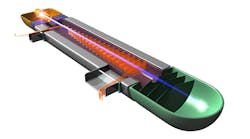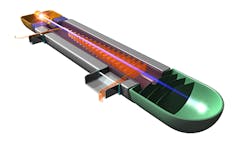Solid-state electronics began to overtake vacuum tubes in radios, computers, and other electronic and radio frequency gadgetry more than 60 years ago. Now we live in a Silicon Age. Even so, vacuum electronic devices, whose origins date to the 19th century, touch our lives every day.
Those microwaves that heat the food in your microwave oven come from a magnetron, the vacuum tube that made radar possible in the first half of the 20th century. Traveling wave tubes (TWTs), not solid-state amplifiers, generate the strong electromagnetic signals in communication satellites because of their exceptional on-orbit reliability and high power efficiency. And it’s the unique ability of vacuum-tube electronic devices to generate high-frequency signals at chip-melting operating powers that makes possible modern aviation radar systems for navigation and collision avoidance. What’s more, there are more than 200,000 vacuum electronic devices (VEDs) now in service in the Department of Defense, powering critical communications and radar systems that cover the land, sea, air, and space.
With its new Innovative Vacuum Electronic Science and Technology (INVEST) program, DARPA aims to develop the science and technology base for new generations of more capable VEDs.
“Any time you need to operate at the outer reaches of the power-frequency parameter space, vacuum tubes are the technology of choice,” said Dev Palmer, program manager for INVEST in DARPA’s Microsystems Technology Office (MTO). “But at the high millimeter-wave frequencies of interest to this program, the design and construction of VEDs is an intricate, labor-intensive process that requires exquisite modeling tools, exotic materials, and expensive, high-precision machining.” Physical scaling laws have been the showstopper for millimeter-wave VEDs so far: As engineers push the operating frequency of electronic devices upward, the output power from the same devices goes down. With INVEST, Palmer aims over the next four years to create a community of researchers that will find ways through this technical bottleneck.
Notwithstanding the popular notion that vacuum electronics are old-fashioned, the incentive to overcome technical and cost barriers to obtain next-generation VEDs is only getting stronger. “The worldwide availability and proliferation of inexpensive, high-power commercial amplifiers and sources has made the electromagnetic spectrum crowded and contested in the radio frequency (RF) and microwave regions,” according to MTO’s just-published Broad Agency Announcement (BAA), which invites the technical community to submit proposals for research that would take VED technology to new heights of power and frequency (DARPA-BAA-15-40, published on August 11, 2015, is available on FedBizOpps: http://go.usa.gov/3HqK9.)
VEDs capable of operating at higher frequencies and shorter wavelengths (in the millimeter wave region) than can outperform the current generation of devices will provide significant defense advantages. Higher power operation yields RF signals that are “louder” and thereby harder to jam and otherwise interfere with. Meanwhile, higher frequency operation brings with it vast swaths of previously unavailable spectrum. This, too, opens the way to more versatile communication, data transmission, and other capabilities that will be beneficial in both military and civilian settings.
To open pathways towards those advances, the INVEST program aims to strengthen the science and technology base for new generations of vacuum tubes operating at millimeter-wave frequencies above 75 GHz. Those awarded contracts under the program will take on fundamental research projects in areas that include physics-based modeling and simulation of VEDs, innovative component design, electron emission processes, and advanced manufacturing. “As you push frequencies up, you can’t use conventional manufacturing techniques anymore,” Palmer said, pointing to the tiny size and ultra-precise alignment of millimeter-wave VED components, among them high-current-density cathodes, tiny vacuum envelopes, and microparts that extract the RF signals amplified inside the component.
“If you could print the whole structure with a 3-D printer so that everything was aligned right off the assembly line, it would make it much easier,” Palmer said. Indeed, an ultimate and most welcome outcome would be to transform the new scientific understanding and engineering know-how that emerges from the INVEST program into novel tools for analyzing, synthesizing, and optimizing new VED designs and then deploying innovative advanced manufacturing methods, including 3-D printing, to actually produce the devices. “That is a beautiful vision,” said Palmer, adding, “Vacuum electronics is an infinitely deep subject.”
Palmer’s own fascination with the technology dates to his junior-high-school days in the 1970s when he was playing his electric guitar through the glowing vacuum tubes of his amplifier—something he continues to do today in his free time, with a continuing preference for tube-based amplifiers over solid-state ones because of the subtle acoustical enhancements the “old” technology offers.
“You have electromagnetics. You have high-temperature mechanical design. You have high-vacuum, magnetics, and materials science. It takes a choreographed effort across many disciplines to create one of these vacuum tubes.”

